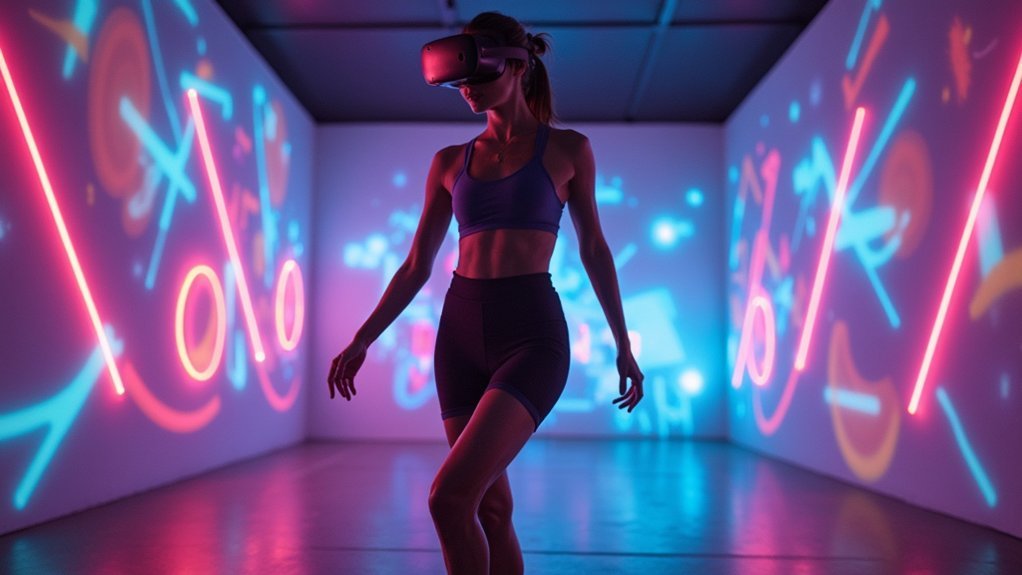The best consumer eye tracking VR headsets for 2023 include the Meta Quest Pro with dual tracking systems and foveated rendering, Apple Vision Pro featuring 4K micro-OLED displays and instant gaze response, HTC Vive Pro Eye offering 0.1° precision for professional applications, and Pico 4 Enterprise with dual 4K displays for business use. You’ll need to evaluate your budget and accuracy requirements, as options range from $500 basic trackers to high-end models exceeding $10,000. Below you’ll discover detailed specifications and performance comparisons.
Top Eye Tracking VR Headsets of 2023
The landscape of eye tracking VR headsets has transformed dramatically in 2023, offering consumers unprecedented levels of immersion and interaction.
You’ll find the Meta Quest Pro leading the pack with integrated eye tracking that enhances your VR experiences through real-time analytics.
The HTC Vive Pro Eye remains a standout PC headset, delivering foveated rendering technology that optimizes performance by reducing graphical load in your peripheral vision.
Meanwhile, the HP Reverb G2 Omnicept Edition provides valuable user behavior data while maintaining high quality visuals for both gaming and professional applications.
These headsets represent the pinnacle of eye tracking innovation, transforming how you engage with virtual environments and creating truly immersive VR experiences that respond naturally to your gaze patterns.
Meta Quest Pro: Advanced Eye and Face Tracking Technology
Meta’s flagship Quest Pro elevates VR interaction through dual advanced tracking systems that capture both your eye movements and facial expressions with remarkable precision.
Powered by the Qualcomm Snapdragon XR2 processor, this headset transforms how you engage with VR experiences through immersive avatar representation and social interactions.
The Snapdragon XR2 processor revolutionizes virtual reality engagement by enabling lifelike avatars and seamless social connectivity in immersive digital environments.
The Quest Pro’s eye tracking technology delivers three key performance benefits:
- Foveated rendering – Reduces processing load by rendering high detail only where you’re looking
- Enhanced resolution – 1,800 by 1,920 pixels per eye with 90Hz refresh rate for smooth visuals
- Professional applications – Ideal for enterprise training, simulations, and virtual meetings
The combined face tracking and eye tracking capabilities make the Quest Pro perfect for developers and businesses seeking cutting-edge immersive technology for professional applications.
Apple Vision Pro: Premium Eye Tracking Performance
While Meta focuses on enterprise applications, Apple’s Vision Pro targets premium consumers with unparalleled eye tracking precision that redefines mixed reality interaction.
You’ll experience revolutionary spatial computing through advanced eye tracking technology that responds to your gaze instantly. The headset’s 4K micro-OLED displays deliver exceptional visual clarity, enabling accurate tracking and immersive experiences worth the $3,499 investment.
You can navigate interfaces effortlessly by simply looking at virtual elements, creating seamless integration between digital and physical environments. The premium performance extends to hand tracking capabilities, offering intuitive control methods.
However, accessibility remains a concern since you can’t wear glasses with the Vision Pro, potentially limiting its usability for users requiring corrective lenses despite its cutting-edge eye tracking features.
HTC Vive Pro Eye: Professional-Grade Tracking Capabilities
You’ll find the HTC Vive Pro Eye stands out with its 2,880 by 1,600 pixel resolution and built-in eye tracking that delivers accurate gaze detection for professional environments.
The headset’s precision tracking capabilities make it ideal for training simulations, research applications, and design work where exact measurements matter.
You can leverage its foveated rendering technology to boost performance while maintaining crystal-clear visuals exactly where you’re looking.
Hardware Specifications Overview
The HTC Vive Pro Eye stands out as a professional-grade headset that combines cutting-edge eye tracking technology with impressive display capabilities.
You’ll experience advanced foveated rendering that intelligently reduces graphical load in your peripheral vision, maximizing performance while maintaining visual quality where you’re looking.
The hardware specifications include:
- High-resolution display delivering 2,880 by 1,600 pixels for crystal-clear visuals
- Dual OLED displays producing vibrant colors and deep blacks for enhanced contrast
- Wider field of view at approximately 110 degrees for natural viewing experiences
You’ll appreciate the comfortable design featuring adjustable straps and memory foam cushioning that supports extended use.
This HTC Vive Pro Eye configuration creates truly immersive experiences, making it ideal for professional applications requiring precise eye tracking capabilities.
Professional Applications Support
Beyond impressive hardware performance, the HTC Vive Pro Eye delivers exceptional value in professional environments where precise gaze tracking becomes a game-changer.
You’ll find this headset excels in training simulations and research settings, where its 120Hz eye tracking sampling rate provides detailed analysis of user attention and engagement.
The dual AMOLED displays create an immersive experience that’s perfect for usability testing scenarios. You can leverage the technology for neuromarketing research, gathering valuable insights about visual focus and user behavior patterns.
The headset’s compatibility with numerous professional software applications makes it versatile for businesses seeking advanced VR solutions.
Whether you’re conducting research studies or developing training programs, the HTC Vive Pro Eye’s professional applications support transforms how you analyze and understand user interactions in virtual environments.
Precision Tracking Performance
Professional-grade precision defines the HTC Vive Pro Eye’s tracking capabilities, delivering eye tracking accuracy that meets demanding research and enterprise standards.
You’ll experience precision tracking through its 60Hz sampling rate, ensuring smooth data capture for professional applications in virtual reality environments.
The system’s advanced capabilities include:
- Gaze Detection Accuracy – Precise tracking enables dynamic focus and interaction based on where you’re looking
- Foveated Rendering Support – Reduces graphical load while maintaining high visual fidelity where your eyes focus
- High-Resolution Integration – 2,448 by 2,448 pixels per eye complement eye tracking for immersive experiences
This precision tracking performance makes the HTC Vive Pro Eye invaluable for neuromarketing research and user experience studies, where accurate gaze data drives meaningful insights and enhanced virtual reality interactions.
Pico 4 Enterprise: Business-Focused Eye Tracking Solutions
When enterprise applications demand sophisticated eye tracking capabilities, Pico 4 Enterprise delivers an all-inclusive solution that’s specifically engineered for business environments.
You’ll get dual 4K LCD displays providing 2,160 by 2,160 pixels per eye for crystal-clear high resolution visuals during presentations and training sessions. The integrated eye tracking technology enhances user interaction through precise gaze detection, while the 105-degree field of view creates an immersive experience without compromising comfort.
At just 300 grams, this lightweight headset won’t cause fatigue during extended professional use.
The remarkably lightweight 300-gram design ensures professionals can wear the headset comfortably throughout lengthy work sessions without experiencing fatigue.
The extensive SDK empowers developers to build customized applications that leverage eye tracking data for your specific business applications. Whether you’re conducting training programs or interactive presentations, Pico 4 Enterprise transforms how you engage with professional VR content.
Eye Tracking Features and Performance Comparison
While all eye tracking headsets promise enhanced immersion, their actual performance varies dramatically across key metrics that’ll directly impact your experience.
When comparing eye tracking performance across leading headsets, you’ll notice significant differences in capabilities:
- Accuracy levels – High-end models like the HTC Vive Pro Eye achieve precision within 0.1° for research applications, while budget options lack such exactness.
- Foveated rendering efficiency – The Meta Quest Pro excels at delivering high detail in your direct line of sight while optimizing peripheral performance.
- Display integration – The Pimax 8K X combines eye tracking with high-resolution displays and wide field of view for thorough visual fidelity.
This performance comparison reveals that accuracy and rendering optimization capabilities determine whether your eye tracking investment delivers professional-grade results or basic functionality.
Choosing the Right Eye Tracking Headset for Your Needs
When you’re shopping for an eye tracking headset, you’ll face the classic tradeoff between what you can afford and the performance you actually need.
Your specific research goals should drive this decision – basic usability studies might work fine with a $500 tracker, while cognitive neuroscience research demands the 0.1° precision that only high-end models deliver.
You can’t ignore how your application requirements directly impact which price tier makes sense for your work.
Budget Vs Performance
As you evaluate eye tracking headsets, you’ll discover that the relationship between price and performance creates distinct tiers that serve different research objectives.
The three main categories break down as follows:
- Budget-friendly models ($100-$1,000) – Perfect for initial studies and basic research, though they lack advanced features and precision.
- Mid-range options ($1,001-$10,000) – Deliver reliable performance for neuromarketing and UX testing, striking an ideal balance between cost and functionality.
- High-end eye tracking devices ($10,001+) – Provide superior accuracy essential for cognitive neuroscience and automotive testing.
Your specific research needs should guide this decision. While budget models work for preliminary investigations, complex studies requiring foveated rendering and dynamic focus demand premium devices.
Mid-range options often satisfy most professional applications without the premium price tag.
Research Application Requirements
Beyond budget considerations, your research application determines which eye tracking features you’ll actually need. Your target application drives accuracy requirements—detailed studies demand precision as low as 0.1°, while basic research tolerates higher margins. Sampling rate becomes critical for dynamic scenarios where fast movements occur.
| Application Type | Accuracy Needed | Sampling Rate |
|---|---|---|
| Basic Research | 0.5-1.0° | 60-120 Hz |
| Detailed Studies | 0.1-0.3° | 250-500 Hz |
| Immersive Studies | 0.2-0.5° | 120-250 Hz |
Screen-based trackers suit traditional research within budget constraints, while VR headsets with advanced eye tracking technologies enable immersive studies. Compatibility with existing software tools remains essential—ensure your chosen headset integrates smoothly with current methodologies. Advanced options offer superior data depth but require careful evaluation against actual research needs.
Frequently Asked Questions
What Is the Best Value for Money VR Headset?
You’ll find the Meta Quest 3 offers the best value at $500, delivering high-resolution displays, powerful processing, and mixed reality features that justify its price for most users.
What Has the Best Face Tracking?
You’ll find Meta Quest Pro offers the best face tracking with its internal cameras capturing real-time facial expressions for avatars. It’s specifically designed for enhanced social VR interactions, outperforming other headsets.
What VR Is Everyone Using?
You’ll find most people using the Meta Quest 3 since it’s the most popular standalone headset. PlayStation 5 owners often choose PSVR2, while serious gamers prefer Valve Index for advanced features.
Is Eye Tracking in VR Worth It?
You’ll find eye tracking worthwhile if you’re into high-end VR gaming or professional applications. It dramatically improves performance through foveated rendering and creates more natural interactions, though it’s still pricey for casual users.
In Summary
You’ve got excellent eye tracking headset options in 2023, whether you need professional-grade precision or consumer-friendly features. The Meta Quest Pro offers the best balance of performance and value, while Apple’s Vision Pro delivers premium tracking capabilities. Consider your specific use case—gaming, enterprise applications, or development work—and budget when making your final decision. Each headset brings unique strengths that’ll enhance your VR experience considerably.





Leave a Reply